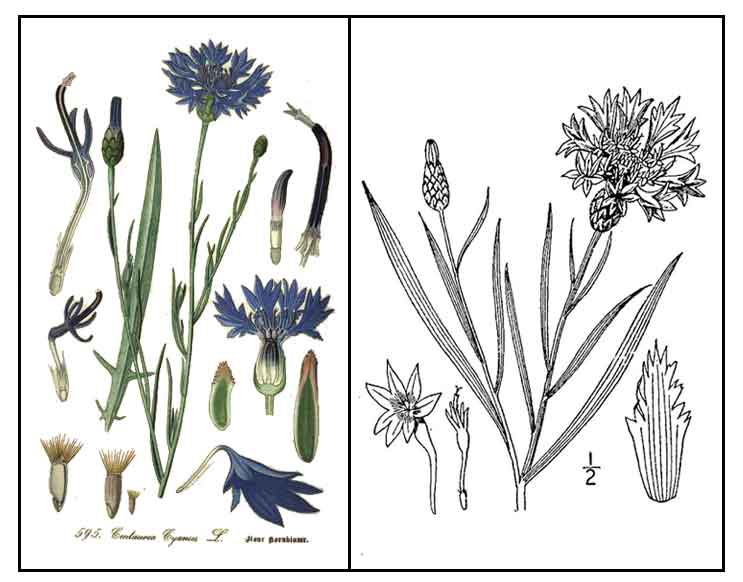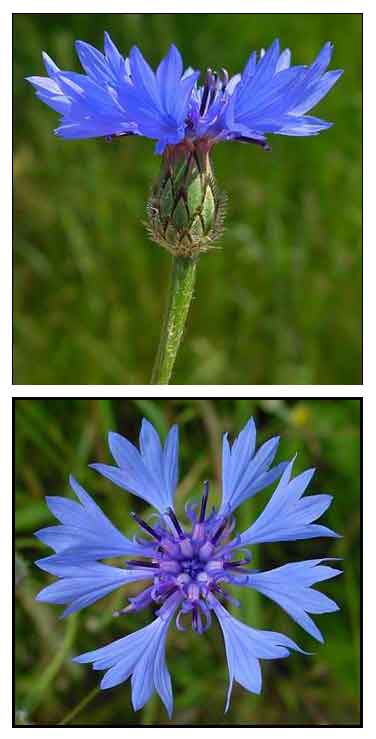 Gen info Gen info
- Centaurea cyanus is an annual flowering plant in the family Asteraceae native to Europe.
- It has been present in Britain and Ireland as an archaeophyte (ancient introduction) since the Iron Age.
- Etymology: For the genus name Centaurea, the Swedish botanist Carl Linnaeus used the word centaur--the mythological half-man, half-horse, more specifically, referring to the centaur Chiron. The specific epithet cyanus means dark blue.
- In the symbolic language of flowers, the cornflower flower is associated with love, fertility, hope, anticipation, patience, delicacy, refinement, and single blessedness. In other social occasions, a man wearing of a single cornflower is indicates and signals celibacy; worn by a woman, it also signs eligibility for marriage. Another folksy version is its use in the love-game of divination, the petals pulled off one at a time, in the formulaic cadence of "loves-me-loves-me-not", until the last petal remains. (20)
 Botany Botany
Coral flower is an annual ground herb growing up to 50 centimeters tall. Stems are slender and wiry. Lower leaves are pinnately dissected, the upper leaves linear, covered with grayish, short hairs. Inflorescence heads are ovoid, 3 centimeters across. Flowers are blue to purple, pink to red, or cream to white. Fruit is an achene.
Centaurea cyanus is an annual plant growing to 40–90 cm tall, with grey-green branched stems. The leaves are lanceolate and 1–4 cm long. The flowers are most commonly an intense blue colour and arranged in flowerheads (capitula) of 1.5–3 cm diameter, with a ring of a few large, spreading ray florets surrounding a central cluster of disc florets. The blue pigment is protocyanin, which in roses is red. Fruits are approx. 3.5 mm long with 2–3 mm long pappus bristles. (14)
Distribution
- Introduced.
- Cultivated in Baguio City.
- Ornamental cultivation for its intense blue flowers.
- Native to the Mediterranean.
- Naturalized in many parts of the world through introduction as an ornamental garden plant.
Constituents
- Phytochemical study yielded flavonoid aglycons (quercetin, kaempferol, isorhamnetic, apigenin, luteolin, hispidulin) and their glycosides, and caffeic, chlorogenic, neochlorogenic, and isochlorogenic acids from the epigeal parts. Ten amino acids were also identified. (3)
- Study of flowers for phenolic compounds yielded phenilpropanic substances, flavonoids, anthocyanins, and tannnins.
(12)
- Qualitative study of herb and flowers for yielded 18 amino acids with total content of 4.77 mg/100mg and 5.41 mg/100 mg respectively, with flowers containing 31.34% and herb 25.70% of essential amino acids from sum of amino acids.
In herbs, dominant amino acids were proline (0.94 mg/100mg), glutamic (0.70 mg/100mg), and aspartic (0.64 mg/100mg) acids, and leucine among the essential one (0.27 mg/100mg) and lysine (0.24mg/100mg). In flowers, aspartic acid (0.82 mg/100mg), glutamic acid (0.68mg/100mg), and proline (0.53mg/100mg) were dominant substitutes for lysine (0.46 mg/100mg), leucine (0.36mg/100mg)), and threonine (0.28mg/100mg). (21)
- GC study of flowers and herbs for fatty acids
identified 13 fatty acids in both flowers and herbs. Unsaturated fatty acids, particularly, linoleic, linolenic, and oleic acids were dominant in cultivated cornflower flowers and herbs, as well as in wild cornflower. Palmitic acid was the most abundant saturated fatty acid. (22)
Properties
- Anti-inflammatory, anti-rheumatic.
- Dried flowers considered antipruritic, antitussive, astringent, weakly diuretic, emmenagogue, ophthalmic, mildly purgative, and tonic.
- Studies have suggested anti-inflammatory, gastroprotective, antioxidant, antibacterial, immunological, antihypertensive properties.
Parts used
Flowers, leaves seeds.
Uses
Culinary
- Blue cornflower has been used to flavor and color tea blends.
- Fresh or dried petals used as decorations in salads, cakes and dessert dishes.
Folkloric
- No reported folkloric medicinal use in the Philippines.
- Externally, blue cornflower used as anti-inflammatory and astringent herb for ocular inflammation and as skin cleanser.
- Eye wash from blossoms use for conjunctivitis, also to relieve eye strain and puffy eyes.
- Infusion of blue blossoms used as curative and calming for nervous disorders.
- Infusion taken as bitter tonic and stimulant; also to improve digestion.
- Seeds used as mid laxative for children.
- Leaves used to create a cleansing facial steam for dry sensitive skin.
- Leaf decoction used as antirheumatic.
- Stem juice used as mouth rinse and to stop bleeding.
- Inside of stem used as poultice for aching muscles.
- Infusion of dried flowers used as mouthwash for ulcers and bleeding gums.
- Flower decoction used to prevent kidney stones.
Others
- Ornamental: Blue flowers retain colors well, a favorite in flower arrangements.
Studies
• Epoxylignans / Seeds: Study yielded epoxylignans, berchemol (1) and lariciresinol 4-O-b-d-glucopyranoside (2) in the seeds of C. cyanus. (4)
• Anti-Inflammatory: Preliminary studies have shown anti-inflammatory properties. Blue cornflower reduced the recurrence of urinary tract stones in one clinical trial.
• Phenolic Compounds / Flower Colors: Study investigated the phenolic compound content and pharmacologic effects of different colors of flowers. Phytochemical testing yielded phenilpropanic substances, flavonoids, anthocyanins and tannins. Results showed anthocyanins, the main metabolites that confer phamacologic effects to C. cyanus, to be more concentrated in the red flowers (4-5 times more than in blue inflorescences). Other phenolic compounds were higher in the red flowers.
• Gastroprotective / Flower Heads and Aerial Parts: Qualitative studies on tinctures and crude aqueous, ethanol, and acetone extracts of flower heads and aerial parts yielded gastroprotective compounds: quercetin, apigenin, and caffeic acid derivatives. Pharmacologic studies on rats with stress-induced ulcer showed high effectiveness of C. cyanus based vegetal products, even greater than the reference drug. (7)
• Weed with Medical Features: Report made a case for Centaurea cyanus as a weed that should not be totally destroyed, but maintained at a low level of negative influence over agricultural cultures, protected, and even cultivated for medical purposes. (8)
• Cornflower Honey / Antibacterial / Digital Dermatitis: Study defined markers for floral origin: lumichrome (18.8–43.5 mg/kg), 7-carboxylumichrome, (Z/E)-3-oxo-retro-α-ionol, and 3-oxo-α-ionol - to distinguish cornflower honey from other unifloral honeys. Cow's hoof disease (digital dermatitis) treated with cornflower honey showed significant faster healing than control group without treatment. (9)
• Anthocyanin in Blue Flowers: The anthocyanin was reported as cyanidin 3,5-diglucoside, namely cyanin. Study showed the major anthocyanin in blue cornflower is not cyanin but cyanidin 3-succinyl glucoside 5-glucoside, presently called centaurocyanin. It is not considered that this anthocyanin forms the blue complex pigment protocyanin. (10)
• Anti-Inflammatory / Immunological Effects / Flowerheads: Different pharmacological experiments (inhibition of carrageenan, zymosan, and croton oil-induced edemas, inhibition of plasma hemolytic activity, induction of anaphylatoxin activity) showed polysaccharides extracted from C. cyanus flower-heads had anti-inflammatory activity and interfered with complement. (11)
• Anti-Leukemic: Study evaluated the in vitro cytotoxic properties of ethanol extracts of six selected Asteraceae species, including Centaurea cyanus on J-45.01 human acute T leukemia cell line. All samples showed antileukemic properties and induced cell death via apoptosis. The activity correlated with total polyphenolic content. The highest IC50 value characterized the inflorescences of Centaurea cyanus (0.77 mg/mL). (13)
• Antioxidant / Antihypertensive / Petals: Study evaluated the phytochemical constituents and functional properties of C. cyanus petals. Results showed temperature and time influenced (p≤0.05) the content of flavonoids, anthocyanins, and FRAP. Only temperature affected total phenolic content, non-anthocyanin flavonoids, and antioxidant (DPPH) activity. Optimized extract yielded chlorogenic, caffeic, ferulic, and p-coumaric acids, isoquercitrin, and coumarin as major compounds. The optimised extract exhibited anti-hemolytic and anti-hypertensive activity in vitro. The petals aqueous extract exhibited low cytotoxicity for tested cell lines (>900 µg/mL). On stress oxidative assay, the extract exhibited pro-oxidant action (10-100 µg/mL) but did not cause damage or cell death. (15)
• Diuretic: Study evaluated and compared the effect of cornflower water and hydrochlorothiazide on diuresis, Na(+) and K(+) excretion, and changes in prostaglandin E2 and kinin levels in the blood plasma in male Wistar rats. Cornflower water extract exhibited diuretic activity, higher than control group lower than than of hydochlorothiazide. Kinin levels showed not statistically significant difference between cornflower and control groups. (16)
• Moschamine: Moschamine is a phenylpropenoic acid found in plants. Study reported on the synthesis and two biological activities (serotoninergic and cyclooxygenase (COX) inhibitory activities) and bioavailability of moschamine. Study showed moschamine may suppress cAMP formation via binding to 5-HT1 receptors in the cells. Moschamine was able to inhibit COX-1 by 58% (p<0.012) and COX-II by 54% (p<0.014, at concentration of 0.1 µmol L. (17)
• Secretory and Volatile Compounds in Petals: Study evaluated flower tissues responsible for the production of secretory products in petals and analyzed the volatile compounds. Sesquiterpenes constituted the main group of volatile compounds, with highest content of ß-caryophyllene (26.17%) and α-humulene (9.77%). Given the abundant secretion residues on the epidermal surface, the C. cyanus secretion released by the flowers is likely a resinaceous mixture (oleoresin). The secretion may play an important role in the therapeutic effects of C. cyanus flowers. (19)
• Effect of Drying on Bioactivity and Antioxidant Activity of Petals: Study evaluated the effects of hot-air convective drying and freeze-drying on bioactive compounds and antioxidant activity of C. cyanus petals. All dried samples showed lower titratable acidity, lower carotenoids, and hydrolysable tannin contents, and greater antioxidant activity. On drying methods, shade drying showed highest values for monomeric anthocyanins, flavonoids, hydrolysable tannins, total reducing capacity and antioxidant activity. Greater losses were noted with hot-air convective drying. Shade drying is suggested as the suitable drying method for Centaurea petals. (23)
Availability
-
Cultivated.
|

![]()



 Gen info
Gen info
